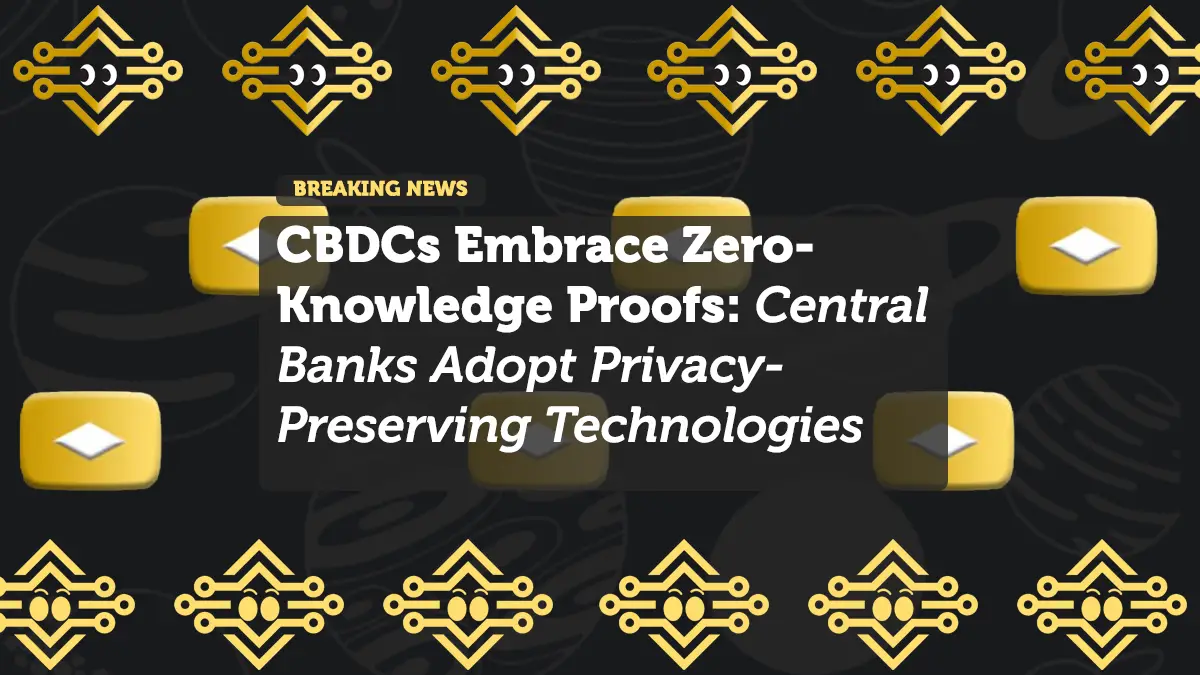
CBDCs Embrace Zero-Knowledge Proofs: Central Banks Adopt Privacy-Preserving Technologies
The CBDC privacy technology landscape has entered a critical phase as major central banks worldwide integrate zero-knowledge proofs (ZKPs) into their digital currency designs. According to a July 2025 Bank for International Settlements (BIS) report, 14 of the 18 central banks with advanced CBDC projects now incorporate privacy-preserving technologies—representing a dramatic shift from earlier designs that prioritized surveillance over user privacy.
This evolution addresses one of the most significant criticisms of early CBDC proposals: the potential for unprecedented government financial surveillance. By implementing ZKPs, central banks can verify transaction legitimacy without exposing sensitive user data—a technical solution that balances regulatory requirements with privacy concerns.
How Zero-Knowledge Proofs Are Being Implemented
The CBDC privacy technology implementation varies across jurisdictions but follows several common patterns:
- Tiered Privacy Models: The European Central Bank’s digital euro design includes tiered privacy levels—small transactions remain private while larger transactions reveal necessary information
- Selective Disclosure: Sweden’s e-krona prototype allows users to share specific transaction details with authorities while keeping other data private
- On-Device Processing: The U.S. Federal Reserve’s Project Hamilton Phase 2 utilizes on-device ZKPs to verify transactions without exposing user identities
- Regulatory Compliance by Design: China’s digital yuan now incorporates ZKPs to verify merchant compliance without exposing consumer spending patterns
These implementations demonstrate how central banks are moving beyond the false dichotomy of “total surveillance vs. no regulation” toward more nuanced privacy frameworks.
Technical Breakthroughs Enabling Privacy
The CBDC privacy technology advancement stems from several key technical developments:
- zk-SNARKs Optimization: Recent improvements have reduced verification times from seconds to milliseconds, making ZKPs viable for high-volume payment systems
- Hardware Integration: New secure enclaves in mobile devices enable on-device ZK proof generation without exposing sensitive data
- Standardized Protocols: The International Organization for Standardization (ISO) recently approved ISO/IEC 23232 for ZKP implementation in financial systems
- Interoperability Frameworks: Central banks are developing shared protocols for cross-border ZK verification
These technical advances have made privacy-preserving CBDCs technically feasible where they were previously considered impractical for large-scale implementation.
Real-World Implementation Examples
The CBDC privacy technology transition is already visible in active implementations:
- Norway’s Norges Bank: Launched a pilot with 50,000 users where ZKPs verify transaction legitimacy without exposing sender/receiver identities for transactions under 10,000 NOK
- Brazil’s Central Bank: Implemented a privacy layer for its DREX CBDC that allows tax authorities to verify income without seeing individual transaction details
- Singapore’s Project Orchid: Uses ZKPs to enable private cross-border payments between participating financial institutions
These implementations have reduced privacy-related concerns among citizens—from 78% opposition in early surveys to 42% in recent polls as privacy features became clearer.
Balancing Privacy and Regulatory Requirements
The CBDC privacy technology challenge centers on balancing competing needs:
- User Privacy: Protecting transaction details from unnecessary surveillance
- AML/CFT Compliance: Meeting anti-money laundering and counter-terrorist financing requirements
- Monetary Policy: Ensuring central banks can implement effective monetary policy
- Financial Inclusion: Designing systems accessible to all citizens
ZKPs address this balance by enabling “compliance by design”—where regulatory requirements are met without exposing unnecessary user data. For example, a ZKP can verify that a transaction doesn’t exceed legal limits without revealing the actual transaction amount.
Market Implications and Industry Response
The CBDC privacy technology shift has significant implications:
- Blockchain Industry Growth: Privacy-focused blockchain companies have seen 220% revenue growth as central banks seek implementation partners
- Standardization Efforts: The World Economic Forum has launched a working group on CBDC privacy standards
- Commercial Applications: Privacy-preserving technologies developed for CBDCs are being adapted for commercial payment systems
- Regulatory Clarity: Clearer guidelines for privacy in digital finance are emerging from central bank implementations
Major technology providers like Consensys, Polygon Labs, and StarkWare are now working directly with central banks to implement these privacy solutions.
Final Thoughts: A New Paradigm for Digital Currency Privacy
The CBDC privacy technology evolution represents more than just technical implementation—it signals a fundamental shift in how society views financial privacy in the digital age. By embracing zero-knowledge proofs, central banks acknowledge that privacy and regulation aren’t mutually exclusive but can be harmonized through thoughtful technical design.
For the broader crypto ecosystem, this trend:
- Validates privacy-preserving technologies long championed by the blockchain community
- Creates new use cases for ZK technology beyond cryptocurrency
- Establishes regulatory frameworks that could benefit decentralized applications
- Demonstrates how thoughtful technical design can address legitimate regulatory concerns
As CBDC development enters its critical implementation phase, the integration of privacy-preserving technologies represents a win-win for both citizens concerned about financial surveillance and regulators needing to maintain oversight capabilities. This balanced approach may well become the standard for digital financial infrastructure across both public and private sectors.











